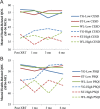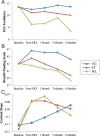Examining Mediators and Moderators of Yoga for Women With Breast Cancer Undergoing Radiotherapy
- PMID: 26867802
- PMCID: PMC4972683
- DOI: 10.1177/1534735415624141
Examining Mediators and Moderators of Yoga for Women With Breast Cancer Undergoing Radiotherapy
Abstract
Hypothesis This study examines moderators and mediators of a yoga intervention targeting quality-of-life (QOL) outcomes in women with breast cancer receiving radiotherapy.Methods Women undergoing 6 weeks of radiotherapy were randomized to a yoga (YG; n = 53) or stretching (ST; n = 56) intervention or a waitlist control group (WL; n = 54). Depressive symptoms and sleep disturbances were measured at baseline. Mediator (posttraumatic stress symptoms, benefit finding, and cortisol slope) and outcome (36-item Short Form [SF]-36 mental and physical component scales [MCS and PCS]) variables were assessed at baseline, end-of-treatment, and 1-, 3-, and 6-months posttreatment. Results Baseline depressive symptoms (P = .03) and sleep disturbances (P < .01) moderated the Group × Time effect on MCS, but not PCS. Women with high baseline depressive symptoms in YG reported marginally higher 3-month MCS than their counterparts in WL (P = .11). Women with high baseline sleep disturbances in YG reported higher 3-months MCS than their counterparts in WL (P < .01) and higher 6-month MCS than their counterparts in ST (P = .01). YG led to greater benefit finding than ST and WL across the follow-up (P = .01). Three-month benefit finding partially mediated the effect of YG on 6-month PCS. Posttraumatic stress symptoms and cortisol slope did not mediate treatment effect on QOL. Conclusion Yoga may provide the greatest mental-health-related QOL benefits for those experiencing pre-radiotherapy sleep disturbance and depressive symptoms. Yoga may improve physical-health-related QOL by increasing ability to find benefit in the cancer experience.
Keywords: QOL; breast cancer; mediation; moderation; yoga.
© The Author(s) 2016.
Conflict of interest statement
Figures



Similar articles
-
Randomized, controlled trial of yoga in women with breast cancer undergoing radiotherapy.J Clin Oncol. 2014 Apr 1;32(10):1058-65. doi: 10.1200/JCO.2012.48.2752. Epub 2014 Mar 3. J Clin Oncol. 2014. PMID: 24590636 Free PMC article. Clinical Trial.
-
Yoga Program for High-Grade Glioma Patients Undergoing Radiotherapy and Their Family Caregivers.Integr Cancer Ther. 2018 Jun;17(2):332-336. doi: 10.1177/1534735417689882. Epub 2017 Feb 2. Integr Cancer Ther. 2018. PMID: 28150503 Free PMC article.
-
Yoga improves quality of life and benefit finding in women undergoing radiotherapy for breast cancer.J Soc Integr Oncol. 2010 Spring;8(2):43-55. J Soc Integr Oncol. 2010. PMID: 20388445
-
Effects of yoga on psychologic function and quality of life in women with breast cancer: a meta-analysis of randomized controlled trials.J Altern Complement Med. 2012 Nov;18(11):994-1002. doi: 10.1089/acm.2011.0514. Epub 2012 Aug 21. J Altern Complement Med. 2012. PMID: 22909345 Review.
-
Effects of yoga on improving quality of life in patients with breast cancer: a meta-analysis of randomized controlled trials.Breast Cancer. 2021 Mar;28(2):264-276. doi: 10.1007/s12282-020-01209-6. Epub 2021 Jan 15. Breast Cancer. 2021. PMID: 33452652
Cited by
-
The effectiveness of exercise and/or nutritional interventions to improve the quality of life of women with breast cancer receiving radiation therapy: a scoping review.Support Care Cancer. 2024 Oct 23;32(11):745. doi: 10.1007/s00520-024-08933-1. Support Care Cancer. 2024. PMID: 39441426 Free PMC article.
-
Sleep moderates the effects of Tibetan yoga for women with breast cancer undergoing chemotherapy.Support Care Cancer. 2022 May;30(5):4477-4484. doi: 10.1007/s00520-022-06861-6. Epub 2022 Feb 2. Support Care Cancer. 2022. PMID: 35107599 Free PMC article.
-
Biobehavioral Pathways and Cancer Progression: Insights for Improving Well-Being and Cancer Outcomes.Integr Cancer Ther. 2022 Jan-Dec;21:15347354221096081. doi: 10.1177/15347354221096081. Integr Cancer Ther. 2022. PMID: 35579197 Free PMC article. Review.
-
Bibliometric Analysis of Randomized Controlled Trials on Yoga Interventions for Cancer Patients: A Decade in Review.Cureus. 2024 Apr 25;16(4):e58993. doi: 10.7759/cureus.58993. eCollection 2024 Apr. Cureus. 2024. PMID: 38800314 Free PMC article. Review.
-
Development of a psychological management intervention protocol for colorectal cancer patients: a Delphi study on benefit finding.PLoS One. 2025 Apr 16;20(4):e0321396. doi: 10.1371/journal.pone.0321396. eCollection 2025. PLoS One. 2025. PMID: 40238824 Free PMC article.
References
-
- Stefanek ME, Jacobsen PB, Christensen AJ. The society of behavioral medicine’s “great debate”: an introduction. Ann Behav Med. 2006;32:83-84.
-
- Coyne JC, Lepore SJ, Palmer SC. Efficacy of psychosocial interventions in cancer care: evidence is weaker than it first looks. Ann Behav Med. 2006;32:104-110. - PubMed
-
- Lepore SJ, Coyne JC. Psychological interventions for distress in cancer patients: a review of reviews. Ann Behav Med. 2006;32:85-92. - PubMed
Publication types
MeSH terms
Substances
Grants and funding
LinkOut - more resources
Full Text Sources
Other Literature Sources
Medical

